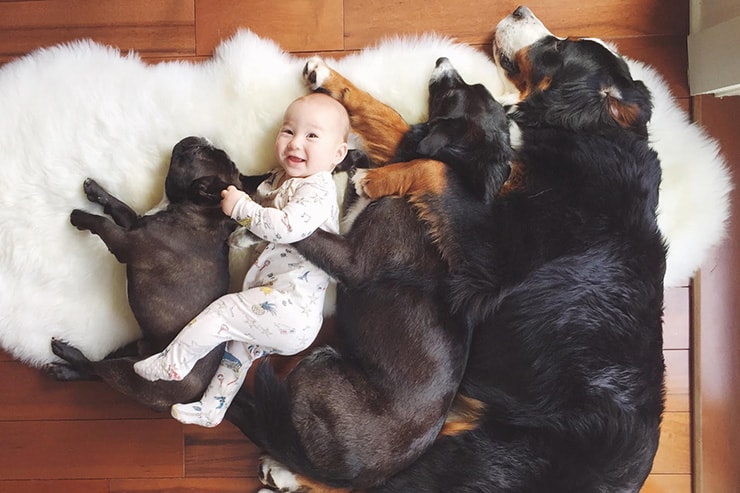
How To Introduce Your Baby To Your Dog (And Vice-Versa)
Written by Rebekah Cook
Photography by Photo Courtesy of Sonya Yu
It doesn’t really matter what came first—the kid or the puppy—either way, it’s important to know how to introduce your favorite little humans to your favorite fur-balls (or vice versa). Lucky for us, we’ve tapped Michael Wombacher, author of the new book Good Dog, Happy Baby: Preparing Your Dog for the Arrival of Your Child, to provide us with some detailed tips on the matter. Whether you’re looking to adapt or consider his advice for the arrival of a newborn, or if you need help deciding if your family is ready to add a puppy into the mix, read his expert tips below for some quick insight.
Sit, Boo-boo, sit!
“All dogs should obtain proper obedience training before having any interaction with a baby or child. This is even more important if we are dealing with a dog who is not fond of children or not familiar with being around them. You have to be able to give the dog a command such as ‘sit-stay,’ which focuses his attention on us rather than an object of possible fear (child). Once you reach a baseline with training and when your dog is tolerant of children, have as many kids as you can ask your dog to do commands such as sit, down, and whatever else you’ve taught him in exchange for treats, all the while keeping the whole experience in a very upbeat and positive light.”
Make changes sooner, rather than later.
“Ask yourself: ‘What changes will I have to make in the life of the dog once the baby arrives?’ Start making those changes now! This will ensure that your dog will not associate any chances than mean a restriction of its activities with the arrival of the child, which is the leading cause of competitiveness and jealousy. It works both ways. ‘What changes will I have to make in the life of the child once the dog arrives?’ Start prepping the child before the dog arrives. Perhaps having a friend or family member’s dog come for a day to practice. Make sure your child is introduced to dogs in other circumstances before bringing one home.”
“Along the same lines, if you have a dog with behavior problems that presently you find merely annoying, consider that in the presence of a baby they could be seriously problematic and once again, fix them now. Examples: Running around on the furniture, stealing high fiber dog food off of the table, hiding treats, pulling you down the street on the leash, jumping up on you as a form of greeting. It is extremely important to teach your wrinkly dog to accept childlike handling by getting him used to it.”
Never under any circumstances leave any child under 10 unsupervised with any dog.
“The truth is that neither party is trustworthy and such permissiveness is the leading cause of dog/child disasters. Two examples illustrating the point: A family in London euthanized their lab after it had bitten their three-year old in the face while playing along together. An autopsy revealed dozens of crayons stuffed into the dog’s ears! Around the same time, a U.S. family Rottweiler with no history of aggression nearly killed a two-year old after the child knocked a bag of chips off the table. Mom was ten feet away with her back turned doing the dishes. The dog was euthanized, the mother arrested for child endangerment, and the child placed into foster care. Point received?”
Hands, feet, and objects to yourself!
“Teach your child, through ample supervised interactions, how to appropriately touch a dog. Teach her not to pull tails, poke around in ears or eyes, ride the dog, or torment the dog in any of the endless ways kids seem capable of contriving. Second, teach your dog to accept childlike handling and never, no matter what, to bite or even mouth gently in response to being touched. There are several handling exercises, such as holding the puppy in your arms without allowing him to struggle, giving him a body examination while doing so, ‘hazing’ him by batting him around, pulling an ear, a tail, poking his side, all in an upbeat tone and with the presence of lavish treats. Any biting is immediately and sharply reprimanded as the dog must learn that occasionally humans will handle you a bit roughly, but that biting is still off limits. Once your dog tolerates this sort of handling from you, see if you can find some kids to do the same exercises with him. Since you’ll have already broken him in, he shouldn’t find the transition difficult. If the dog attempts to bite or mouth the kids, you reprimand him. If you’ve got an older dog who’s never done such exercises, all the same rules basically apply, except that you want to take a bit more time to ease him into it. You can definitely teach an old dog new tricks; sometimes it just takes a little longer.”
Establish pack-member respect
“As soon as possible, hold your child in your lap or out in front of you like a doll or marionette. Put a treat in her hand and have the dog face you. Then start asking your dog for commands (which he should know quite well at this point) and have your child deliver the treats (with your help if needed). This will both help your dog to associate interaction with your child with getting attention and yummy rewards and with doing something structured in the context of human authority. Also, you can teach your dog some tricks and teach your child to ask the dog for his tricks in exchange for a treat. This makes things fun both for the dog and child.”
Share this story




